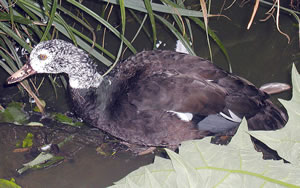Tropical rainforests are a desirable habitat for water birds such as ducks, herons, bitterns and rail.
The rainforests have great river systems, and the low-lying areas near them are often flooded.
Water birds can feed in and beside the rivers, and nest in the trees nearby.
Ducks
The muscovy duck, a familiar farmyard and ornamental duck, is native to the Central and South American rainforests.
 The white-winged wood duck, which is closely related to the muscovy duck, can be found in the Southeast Asian rainforests.
The white-winged wood duck, which is closely related to the muscovy duck, can be found in the Southeast Asian rainforests.
Both species are omnivorous, eating insects, mollusks, small fish and reptiles.
They have well-developed, clawed feet and bony knobs at the angles of their wings which they use to advantage when fighting.
Herons
The tiger heron nests in trees close to small streams and rivulets. The striped pattern in its plumage helps make this shy, secretive bird inconspicuous.
They feed on small fish, crabs, frogs, snakes and insects.
Sunbittern
The sunbittern is a relative of the heron family.
There is only one species and it is restricted to the South American rainforests, particularly to the banks of streams, where it feeds on frogs, insects and other small animals.
Hoatzin
The hoatzin inhabits the more open parts of the tropical rainforest, alongside large rivers and lakes in South America.
Pheasantlike in appearance, it has a slender body, long neck, and a small head crowned by a ragged cluster of stiff feathers.
The hoatzin feeds primarily on mangrove and arum leaves with the aid of its powerful beak.
Its wings are large but its breast muscles are weak. Consequently, it is a poor, laborious flier.
Because its feet are poorly developed the hoatzin moves through vegetation in an ungainly fashion, using its wings and tail as stabilizers and supports.
Hoatzins move in flocks and nest in colonies. Their nests are made of twigs in trees overhanging water.
In contrast to the parents, the young hoatzins are adept at moving nimbly among the branches. They have well-developed feet as well as beaks adapted for climbing.
Young hoatzins have an extra pair of claws on each wing. They use these to cling to branches. The extra claws disappear when the birds reach adulthood.